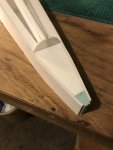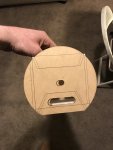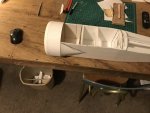Tench745
Master member
While it is a little known aircraft, it is probably the most well known American-built WWI fighter. I'm referring to Ithaca, New York's own "Tommy" Scout.
I found a set of plans for a free-flight model on Outerzone, scaled them up 150% to 1:6 scale and cut out a few pieces to understand how big this plane might be and whether I really want to tackle a build of this scale. Before I knew it I had a good start on a fuselage and was committed.


On the firewall I had a mis-aligned layer on the first pass with my laser, but I caught and corrected it. Annoying, but not worth remaking the part.

The face of the cowling is five layers of paperless DTFB sandwiched together and carved/sanded to shape. A wrap of foam forms the depth of the cowling.



This landing gear, though it looks simple, was probably the most complicated wire bending I've yet done
.
I didn't have a complete plan when I started this (still don't), so I am making things up as I go along.
Underside of the fuselage box cut out for lightness before gluing on the lower turtledeck.

Wing plans printed out and laid in place to visualize the size of this thing... Much smaller than my Spirit of St. Louis, but still not small.

I don't know yet how I want to build the wings, attach them to the fuselage, or actuate the ailerons.
I'm leaning towards a Clark-Y type airfoil with ribs and foam sheathing over wood spars. If I were to do an undercambered wing I would probably hotwire cut it because I don't know how else to achieve that. I want to do something a little more scale than an FT fold-over wing.
I'm thinking I want a central servo in the fuselage operating pushrods and torque tubes for the ailerons like on the full scale, but this will probably mean mounting the wing permanently which I'm not thrilled about.
I plan to do pull-pull cables for the rudder and elevator.
Last of all, I need a power system. I'm saving this one for near last so I can get a sense of how heavy the plane will turn out. Ideally I would like to swing a scale 16" prop, but that would require either a large(ish) motor or a reduction drive on a smaller one. The tinkerer in me wants to make a belt reduction drive, but I doubt I will have the time for that before FF2022.
As ever, I'm open to ideas and suggestions.
I found a set of plans for a free-flight model on Outerzone, scaled them up 150% to 1:6 scale and cut out a few pieces to understand how big this plane might be and whether I really want to tackle a build of this scale. Before I knew it I had a good start on a fuselage and was committed.


On the firewall I had a mis-aligned layer on the first pass with my laser, but I caught and corrected it. Annoying, but not worth remaking the part.

The face of the cowling is five layers of paperless DTFB sandwiched together and carved/sanded to shape. A wrap of foam forms the depth of the cowling.



This landing gear, though it looks simple, was probably the most complicated wire bending I've yet done
.

I didn't have a complete plan when I started this (still don't), so I am making things up as I go along.
Underside of the fuselage box cut out for lightness before gluing on the lower turtledeck.

Wing plans printed out and laid in place to visualize the size of this thing... Much smaller than my Spirit of St. Louis, but still not small.

I don't know yet how I want to build the wings, attach them to the fuselage, or actuate the ailerons.
I'm leaning towards a Clark-Y type airfoil with ribs and foam sheathing over wood spars. If I were to do an undercambered wing I would probably hotwire cut it because I don't know how else to achieve that. I want to do something a little more scale than an FT fold-over wing.
I'm thinking I want a central servo in the fuselage operating pushrods and torque tubes for the ailerons like on the full scale, but this will probably mean mounting the wing permanently which I'm not thrilled about.
I plan to do pull-pull cables for the rudder and elevator.
Last of all, I need a power system. I'm saving this one for near last so I can get a sense of how heavy the plane will turn out. Ideally I would like to swing a scale 16" prop, but that would require either a large(ish) motor or a reduction drive on a smaller one. The tinkerer in me wants to make a belt reduction drive, but I doubt I will have the time for that before FF2022.
As ever, I'm open to ideas and suggestions.


































